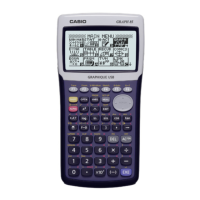
Do you have a question about the Casio Geometry and is the answer not in the manual?
Explains the menu system (F1-F6, OPTN) used in Geometry Mode.
Describes the notation used to show menu operations in the manual.
Details the items available in each menu (File, View, Draw, Construct, Transform, Animate, Option).
Details the View menu options for screen manipulation and zoom.
Details the Edit menu options for undo, select/deselect, and clearing.
Details the Draw menu options for plotting points, lines, circles, polygons.
Details the Construct menu for creating perpendicular bisectors, midpoints, tangents, etc.
Details the Transform menu for reflection, translation, rotation, and dilation.
Details the Animate menu for creating and controlling animations.
Details the Option menu for text, expressions, number format, and hiding/showing objects.
Explains how to move and jump the on-screen pointer.
Describes how to access and use the Key Help function.
Explains how to save and manage files in Geometry Mode.
Steps to open, manage, and delete saved geometry files.
How to save the current file with a new name.
How to use the Draw menu to plot points and draw geometric objects.
Steps to draw points, lines, segments, rays, vectors, circles, and arcs.
Steps to draw triangles, rectangles, squares, polygons, and regular n-gons.
How to select and deselect individual or entire geometric objects.
How to construct geometric elements like bisectors, midpoints, and tangents.
How to perform transformations like reflection, translation, rotation, and dilation.
How to undo or redo the last performed operation.
Steps to move or delete selected geometric objects from the screen.
How to hide specific objects or show all hidden objects.
How to turn the display of axes and grid on or off.
How to enable or disable the integer grid snap feature.
How to set the Xmin, Xmax, and Ymid values for the display window.
Methods for shifting the viewable area of the screen using pan and scroll.
Techniques for enlarging or reducing the screen image using zoom functions.
How to add text strings to the drawing screen.
How to modify existing text strings on the screen.
How to add new labels or change existing labels for geometric objects.
How to display object properties like coordinates, length, slope, and area.
How to set specific measurement values and lock them to prevent object movement.
Examples of viewing line segment properties and calculating areas.
How to set or change the angle and side length of a triangle.
How to lock or unlock specific measurements using an indicator icon.
How to display object measurements directly on the drawing screen.
How to perform calculations using object measurements and display the result.
How to set decimal places or scientific notation for displayed measurements.
Steps to add and run animations for objects, like a point moving on a circle.
Using the trace function to draw the path of a moving point, creating shapes like parabolas.
Modifying animation properties like repeats, steps, and trace points.
Creating tables of animation data, saving columns to lists, or exporting as spreadsheets.
Explains errors related to incorrect object selection for operations.
Explains errors related to animation limits, trace points, and table rows.
Explains errors related to animation settings and table generation.